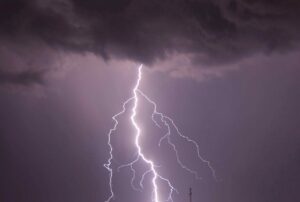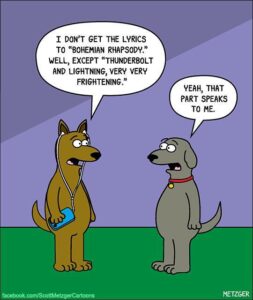What do you do if your dog is afraid of thunderstorms? Or if you have a new puppy?

So what DO you do if your dog is afraid of thunderstorms? Good news. You can help settle your dog down during thunderstorms with some simple tricks.
Note: It’s also good to give young puppies positive experiences during thunderstorms so that they don’t develop any negative associations, and escalating fear. It is not fun having a dog who is afraid of thunderstorms, so if you can try to prevent it early on – you should!
You can help your dog!
The easiest way to help your dog who is afraid of thunderstorms is to distract them, and pair the scary flashing and booms of lightening and thunder with tasty food.
You can do the same thing for puppies so in their mind, thunderstorms always = fun, and are no cause for concern.
I love using the LickiMat Soother for my dogs when a thunderstorm hits unexpectedly. It’s quick and easy to use and helps settle dogs down as they calmly lick the pad.
Other important things to do if your dog is afraid of thunderstorms:
- Bring dogs inside
- Provide them with a safe space they can retreat to e.g. a covered crate
- Some dogs seem to like the bathroom/bathtub as it’s a relief from static electricity
- Close blinds and or turn a light on to reduce flashing from lightening
- Turn some music on to muffle the sounds of thunder. Or turn up the volume on the TV.
- Give your dog something tasty to chew/lick/eat
- Always make sure your dog’s microchip details are up to date and your dog is wearing identification in case you are not home and your dog escapes
Non-Prescription Remedies
Some anxious dogs can respond to “over the counter” remedies. A lot of people say their dogs behaviour as a result of using some of these remedies. Things you can try include:
- Adaptil, also known as “DAP” which stands for Dog Appeasing Pheromone, is a synthetic copy of a pheromone secreted by a lactating female. The function of this pheromone is the calm and reassure the offspring.
It is available as a collar your dog can wear for up to 4 weeks
As a plug in diffuser in your home in a small room that lasts up to 30 days
And as a spray that can be applied to bedding or bandannas for example, which lasts around 2 hours. - Zylkene is a tablet you can give your dog. It contains a product derived from casein, a protein in milk. It’s not fast acting though, you’d need to give it in advance when you see the potential for storms on the forecast. Recommended to be given 1 to 7 days before an event.
- Homeopathy, flower essences, aromatherapy have also been tried to help calm anxious dogs. But before you whip out your essential oils to burn, please research this area carefully. Some can cause serious illness or even death, especially if you have cats.
- ThunderShirt is a vest you can put on your dog. It’s used to create mild pressure – like swaddling an infant. It does work for some dogs. Downside is it’s not good to leave on your dog if it’s hot, and if you only bring it out and put it on during storms your dog may create a negative association with it and dislike it. You might be able to fashion a t-shirt or body wraps yourself that serve the same purpose.
Both Adaptil and Zylkene are marketed as being beneficial for stressful events including sudden noises e.g. fireworks and thunder.

When to seek further help
Storm phobia is a panic disorder. Signs your dog needs more help:
- Your dog won’t eat delicious food
- Constant barking
- Running around frenzied or pacing
- Sweaty paws (can you see your dogs paw print on a hard surface but their paws aren’t wet?)
- Drooling
- Hiding and won’t come out
- Shaking or frozen in place
- Involuntary urination or defecation
- Escaping
Behaviour Vets can prescribed situational medications that help ease your dogs fear. They will work with you and a trainer to help modify your dogs behaviour during storms. Find a Behaviour Vet
I recommend you see a Behaviour Vet as they have extra qualifications in behaviour and can provide appropriate medication.
If you must see your regular vet, make sure they DO NOT prescribe “ACE” Acepromazine it may immobilise your dog with having no effect on reducing their fear or improving their behaviour.
Also see our post on what a behaviourist actually is and why to be careful when hiring someone to help train your dog.
If you need more personal guidance and help with behaviour modification exercises for your dog to help them overcome their thunder fear please contact me for a behavioural consultation
